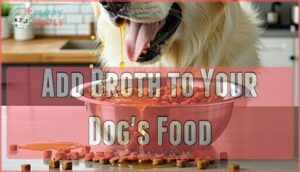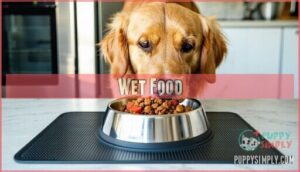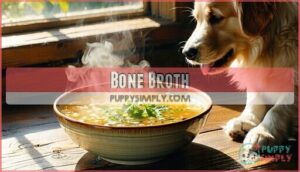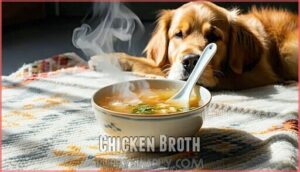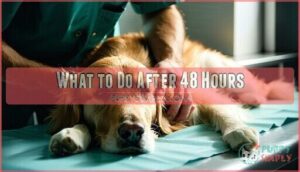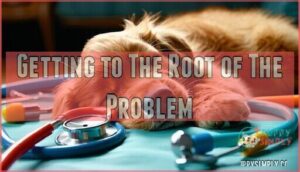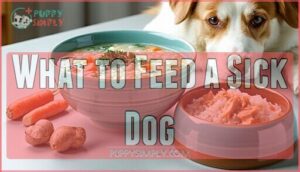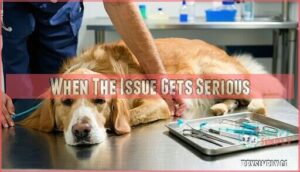This site is supported by our readers. We may earn a commission, at no cost to you, if you purchase through links.
 When your furry friend won’t eat due to illness, don’t panic—this happens more often than you’d think.
When your furry friend won’t eat due to illness, don’t panic—this happens more often than you’d think.
Start by warming their regular food slightly, as the enhanced aroma can jump-start their appetite. Add low-sodium chicken broth to make meals more appealing, or try offering bland options like boiled chicken and rice. Sometimes switching from dry to wet food does the trick.
If your dog’s still turning their nose up after 24 hours, consider hand-feeding small amounts or offering high-value treats to gauge interest. Remember, forcing food isn’t the answer—patience works better.
However, if your pup refuses food for 48 hours, it’s vet time. There are several proven techniques that can make all the difference, and understanding these techniques is key to helping your dog recover, by using methods such as hand-feeding.
Table Of Contents
- Key Takeaways
- Why is My Dog Not Eating?
- When to Contact Your Vet
- Methods for Feeding a Sick Dog
- What Foods Should I Feed My Sick Dog?
- Ensuring Water Intake for a Sick Dog
- What to Do After 48 Hours
- Getting to The Root of The Problem
- Time is a Healer
- What to Feed a Sick Dog
- When The Issue Gets Serious
- Frequently Asked Questions (FAQs)
- Can a sick dog eat homemade food?
- How much should I Feed my dog if he is sick?
- What can I give my dog if he is sick?
- Can a dog get sick from eating too much food?
- Can dogs eat boiled meat if they’re sick?
- Can dogs eat dry food if they’re sick?
- How long will a dog not eat when sick?
- What to do if a dog is being sick and not eating?
- How do I get my dog to eat again after being sick?
- Should I force feed my dog when sick?
- Conclusion
Key Takeaways
- Start with gentle methods first – Try warming your dog’s food, adding low-sodium broth, or switching to wet food to make meals more appealing through enhanced aroma and easier digestion.
- Don’t wait too long to seek help – If your dog refuses food for 48 hours or shows additional symptoms like vomiting, lethargy, or dehydration, contact your vet immediately rather than continuing home remedies.
- Focus on hydration as much as food – Keep fresh water available and consider offering bone broth or ice cubes, since dogs can only survive about three days without water and dehydration can be more dangerous than temporary appetite loss.
- Use patience, not force – Hand-feeding small amounts and offering high-value treats can encourage eating, but never force-feed your sick dog as this creates stress and can worsen their condition.
Why is My Dog Not Eating?
When your furry friend turns their nose up at dinner, it’s like watching a food critic reject their favorite dish.
Appetite loss in dogs signals something’s off, whether it’s digestive issues, stress, or underlying illness.
Several factors trigger food aversion in our canine companions.
When your dog’s dinner becomes their enemy, it’s time to play detective.
Medication side effects commonly suppress appetite, while dental problems make chewing painful.
Environmental changes, like moving homes or loud construction noise, create stress that impacts eating habits.
Gastrointestinal upset from infections or dietary indiscretion also causes dogs to refuse food.
Age plays a role too.
Senior dogs often experience slower metabolism and decreased smell sensitivity, making meals less appealing.
Meanwhile, nutrient deficiency from poor-quality food can paradoxically reduce interest in eating.
Watch for accompanying symptoms like lethargy, vomiting, or diarrhea alongside canine appetite loss.
These red flags suggest your sick dog needs veterinary attention rather than just coaxing with treats.
A dog’s eating patterns reveal their health status, making appetite changes your first clue that something needs addressing.
When to Contact Your Vet
When your dog won’t eat beyond 48 hours, it’s time for veterinary consultation. Emergency signs like vomiting, diarrhea, or lethargy require immediate medical intervention.
Dehydration symptoms—dry gums, skin tenting, excessive panting—signal serious trouble. Your vet will provide refusal diagnosis, identifying underlying causes from dental issues to infections.
Don’t wait if sick dog symptoms worsen or if your pup shows dog illness symptoms alongside appetite loss. Professional veterinary care guarantees proper dog health recovery through targeted treatment plans and appropriate medications.
Methods for Feeding a Sick Dog
When your sick dog won’t eat, don’t panic—there are several gentle methods that can help restore their appetite.
These tried-and-true techniques work by making food more appealing and addressing common barriers that prevent sick dogs from eating, using gentle methods.
Wait
Sometimes patience is your best medicine. An observation period allows your dog’s digestive system to reset after illness.
Wait 12-24 hours before offering food, creating a calm environment that reduces stress. This gentle approach gives their stomach time to settle naturally.
Waiting strategies that work:
- Monitor without hovering – your anxious energy can make them more reluctant to eat
- Keep fresh water available – hydration remains critical during the observation period
- Note any behavioral changes – appetite often returns as other symptoms improve
Your patience techniques during this waiting period set the foundation for recovery. Most dogs naturally regain interest in food once nausea subsides.
Give Your Dog a Treat
When patience doesn’t work, it’s time to pull out the big guns—tasty rewards that’ll make your pup’s tail wag again.
High-value dog treats often succeed where regular kibble fails.
Try warming pet biscuits or offering canine delights like freeze-dried liver, which releases irresistible aromas.
For a sick dog eating reluctantly, consider treat options your dog rarely gets.
Handfeeding dogs creates comfort and connection during illness.
If your dog refuses food entirely, strong-smelling dog snacks like salmon or chicken treats can kickstart appetite.
Mix treats into wet food or use them as appetite stimulants between meals.
Even finicky eaters respond to special canine delights they associate with positive experiences.
Remember, you’re not spoiling your dog—you’re using food psychology to encourage eating when they need nutrition most.
Change Dry Food Brands
Brand switching can spark your dog’s interest when treats fall short.
Try a different dry food brand with natural ingredients and varied textures – your pup might prefer chicken over beef flavors.
Consider kibble alternatives like freeze-dried options that offer different nutrient profiles.
When your dog refuses food, food shift to a premium brand with enhanced flavor options can work as a natural dog appetite stimulant.
Remember, sick dog eating patterns improve with variety, making brand switching effective dog nutrition advice.
Incorporating natural dog food options can also aid in recovery and overall health.
Heat Up Your Dog’s Food
When switching dry food brands doesn’t spark your pup’s interest, it’s time to turn up the heat—literally.
Food Warming transforms even the most unappetizing meal into something irresistible through Aroma Enhancement.
Heat releases those mouth-watering scents that make your dog’s nose twitch with anticipation.
Try microwaving warmed wet food for 10-15 seconds, creating powerful aromatic compounds that boost appeal by up to 25%.
This Meal Heating technique works especially well for dog eating problems, as sick pups often have diminished smell sensitivity.
The gentle warmth mimics body temperature, making food feel more natural and comforting.
Palate Stimulation occurs when heated meals become easier to digest, offering a Nutrient Boost for recovery.
Always test temperature before serving—you want cozy, not scalding.
This dog appetite stimulation technique particularly helps elderly dogs or those recovering from surgery.
The enhanced scents from properly heated dog food for sick dogs can reignite even the most stubborn appetites naturally.
For dogs with decreased appetite, consulting a veterinarian about appetite stimulants can provide valuable guidance and support.
Add Broth to Your Dog’s Food
Adding broth to your dog’s kibble transforms mealtime into something irresistible. This simple trick provides Broth Benefits through Food Enhancement that tackles dog appetite loss head-on.
The warm liquid creates powerful Aroma Stimulation while delivering a Nutrient Boost your pup needs.
Here’s your Meal Mixing game plan for sick dog feeding:
- Use low-sodium bone broth for dogs or homemade chicken broth
- Warm the mixture slightly to enhance the scent
- Start with small amounts to avoid overwhelming your dog
- Let the kibble absorb the liquid for easier chewing
This proven strategy combines hydration with appetite stimulation, making it a cornerstone of effective canine nutrition tips and dog feeding strategies.
What Foods Should I Feed My Sick Dog?
When your dog’s appetite disappears, choosing the right foods can make all the difference in their recovery.
The right food choice transforms a worried pet parent into a relief-filled caregiver.
The key is selecting options that are gentle on their stomach while still providing essential nutrients your pup needs to bounce back.
Wet Food
When battling dog appetite loss, wet food becomes your secret weapon.
The enhanced food aroma and palatable textures in canned options make meals irresistible to sick dogs.
Wet food benefits include 65-85% moisture content, supporting hydration while delivering essential canine nutrition.
These moist diets require less chewing effort, perfect for uncomfortable pups.
Warm the food slightly to amplify scents that trigger appetite.
Using high-quality wet dog food options can help support their nutritional needs during illness, making it a valuable tool in combating appetite loss.
Baby Food
Feeding baby food to your sick pup can jumpstart their appetite when regular meals fall flat. This pureed nutrition offers easy digestion and tempting aromas that often work like magic for canine appetite issues.
- Choose single-ingredient meat options like chicken or turkey without onion, garlic, or additives
- Warm the baby food slightly to enhance smell and encourage your sick puppy eating
- Use Stage I or II varieties as dog supplements, offering just a spoonful at first
- Mix with regular food as a meal topper once appetite returns
Baby food for dogs works best as temporary nutrition during illness recovery, not long-term feeding. Monitoring appetite loss causes is vital to address the root issue and support recovery, which can help support recovery and ensure your dog returns to a healthy state with a good appetite.
Bone Broth
Bone broth works like a gentle hug for your sick pup’s stomach.
This nutrient rich liquid gold delivers essential minerals like calcium and magnesium while supporting healthy digestion.
The warm aroma enhancement can spark even the most stubborn appetite, making it perfect for sick dog care.
Unlike plain water, bone broth tackles canine hydration while providing actual nutrition your dog needs during recovery.
The broth benefits include soothing an upset stomach and delivering easy-to-absorb nutrients when solid food feels overwhelming.
When dog loss appetite strikes, this liquid comfort food often succeeds where kibble fails, making it a cornerstone of dog nutrition tips for canine health issues.
Chicken Broth
Chicken broth works like liquid gold for sick pups who’ve lost their appetite.
This gentle liquid delivers essential nutrients while encouraging hydration through familiar, comforting flavors.
Here are five chicken broth benefits for your sick dog:
- Chicken Nutrition provides easily digestible protein without overwhelming the stomach
- Broth Benefits include electrolyte replacement and gentle nourishment
- Dog Hydration improves when water intake decreases during illness
- Food Enhancement occurs when you mix broth with regular kibble
- Nutrient Boost supports recovery through vitamins and minerals
Low-sodium varieties prevent additional stress on your dog’s system while delivering comfort.
Shredded Chicken
Why won’t your pup touch their usual meal? Shredded chicken offers a gentle solution that’s easy on upset stomachs.
This bland diet staple provides essential protein while being incredibly digestible. Simply boil boneless chicken breast, then shred it into bite-sized pieces your dog can easily manage.
The mild flavor won’t overwhelm sensitive taste buds, making it perfect for dogs recovering from illness. You can serve it plain or mix with a small amount of chicken broth for extra appeal.
Many pet owners find success combining shredded meat with plain rice for a complete, stomach-soothing meal that encourages eating, and it’s a great way to provide a complete meal with essential protein.
Ensuring Water Intake for a Sick Dog
When your dog’s too sick to eat, keeping them hydrated becomes your top priority since dogs can only survive about three days without water.
You’ll need to get creative with encouraging fluid intake, especially if they’re turning away from their regular water bowl, as keeping them hydrated is crucial and they can only survive for a short period without water.
How to Encourage Water Intake
Your dog’s water intake becomes just as important as food when illness strikes. Multiple water bowls throughout your home make hydration convenient, especially for dogs who feel weak or reluctant to move far.
Fresh water refilled daily prevents bacterial buildup that might further discourage drinking. Low-sodium chicken or beef broth transforms plain water into an appealing drink. These hydration tips work because the aroma stimulates interest while providing liquid nutrition.
Freeze diluted broth into ice cubes for a creative twist that encourages licking and chewing. Wet food naturally contains 70-80% moisture compared to dry kibble’s 10%, making it excellent for maintaining electrolyte balance. Add warm water or approved Pedialyte to create a soupy mixture that delivers both nutrition and fluids.
Dog hydration solutions like water fountains attract curious pets through movement and sound. This dehydration prevention method works particularly well for picky drinkers who ignore still water bowls. Monitoring daily water requirements is vital to prevent dehydration, which is why understanding daily water needs is essential for dog owners to maintain proper hydration and prevent dehydration.
Signs of Dehydration
Recognizing dehydration early can save your dog’s life during illness. Watch for the telltale skin elasticity test—gently pinch the skin at your dog’s shoulder blades. If it slowly returns to place, forming a "tent," dehydration has set in.
Dry mouth symptoms include sticky, tacky gums that lose their normal pink shine. Your dog’s nose may appear cracked and dry too. Lethargy signals fluid loss as organs struggle to function properly.
Sunken, dull eyes appear in 90% of dehydrated dogs. Panting increases as body temperature regulation fails. Excessive thirst in dogs paradoxically occurs alongside appetite loss during illness.
Advanced dehydration brings electrolyte imbalance, affecting nerve and muscle function. Heart rates increase as circulation compensates for fluid deficits. Dehydration prevention starts with recognizing these warning signs early.
Hydration solutions for illness become critical when multiple symptoms appear together, especially in sick dogs requiring immediate veterinary attention.
What Not to Feed a Dog
Why risk your dog’s recovery with the wrong foods? When your sick pup needs gentle nutrition, certain human snacks and table scraps become dangerous enemies.
Toxic foods like chocolate, grapes, onions, and garlic can trigger severe vomiting and worsen dehydration. Raw meat carries bacteria that stressed immune systems can’t handle effectively.
Greasy foods from your dinner plate might seem tempting to share, but they’ll likely increase nausea and digestive upset. Banned ingredients including macadamia nuts, raisins, and alcohol can cause serious poisoning during illness.
Stick to vet-approved options instead. Your sick dog’s stomach needs bland, easily digestible meals – not experimental treats that could backfire. Skip the table scraps and focus on gentle, therapeutic foods that support healing rather than hinder it.
What to Do After 48 Hours
If your dog hasn’t eaten after 48 hours, it’s time to take action with targeted strategies to jumpstart their appetite.
Here’s when patience meets persistence—and sometimes a little veterinary backup doesn’t hurt either.
Trying a 1/4 Tab of Original Pepcid AC
Sometimes a little pharmaceutical intervention can turn the tide when your furry friend won’t eat. After 48 hours of food refusal, a quarter tablet of Original Pepcid AC might help reduce stomach acid and nausea in dogs.
The standard Pepcid AC dosage is 0.25-0.5 mg per pound every 12-24 hours, making veterinary approval needed before administration. This antacid use safety measure prevents potential medication side effects like vomiting or diarrhea.
Only use Original formulation—avoid Pepcid Complete or Maximum Strength versions. While Pepcid side effects are generally mild, monitor for allergic reactions or increased lethargy.
Consider Pepcid alternatives if your dog has kidney or liver issues. This dog appetite stimulation method works by calming stomach irritation that causes vomiting after eating, supporting overall dog illness care when combined with proper hydration monitoring.
Whet The Appetite
Appetite stimulation transforms mealtime from a struggle into success.
When your dog’s interest wanes after 48 hours, these proven dog appetite enhancement techniques can reignite their desire to eat:
- Enhance Aroma – Warm wet food or add garlic-free broth to release enticing scents
- Try Hand-Feeding – Personal attention often encourages reluctant eaters through comfort
- Offer Special Foods – Introduce freeze-dried liver treats or boiled chicken as Palatable Foods
- Use Food Toppers – Sprinkle low-sodium broth or fish oil to create appealing mixtures
Hide The Pills
Medication becomes easier when your dog doesn’t realize they’re taking it.
Cheese, peanut butter, or soft treats work well for pill hiding methods.
Check with your vet about food-pill interactions first – some medications need empty stomachs.
If your dog’s getting wise to your tricks, alternative medications like liquids might help.
Smart dogs learn fast, so rotate your pill palatability techniques to stay ahead.
Get Creative
Your dog’s appetite challenges call for creative feeding solutions that transform mealtime into an appealing experience.
Think outside the traditional feeding routine by experimenting with novel approaches that stimulate their senses and reignite their interest in food.
- Food presentation: Serve meals in different bowls, elevate feeding stations, or create puzzle feeders that engage their natural foraging instincts
- Novel flavors: Introduce safe, vet-approved taste enhancers like freeze-dried liver powder or low-sodium bone broth to make ordinary meals extraordinary
- Texture variations: Mix wet and dry foods, blend ingredients into smooth pastes, or offer hand-fed morsels for dogs with oral discomfort
- Feeding environment: Create calm, quiet spaces away from household chaos, or try outdoor feeding sessions for environmental enrichment
These dog appetite stimulation techniques address common dog appetite issues through playful feeding approaches that work.
Patience Wins The Day
Recovery requires patience – rushing won’t help your pup’s dog appetite issues.
Create a calm environment without pressure, allowing gradual reintroduction of food. Maintain consistent routine while using positive reinforcement for small eating victories.
Trust the process; dog appetite loss solutions take time. Your steady presence provides comfort during this challenging period, supporting natural dog appetite stimulation techniques, which can lead to successful appetite stimulation.
Bonus Tip: Visit The Vet
When patience runs thin after 48 hours, it’s time to call in professional backup.
Vet consultation urgency becomes paramount when your sick dog continues refusing food.
Professional diagnosis importance can’t be overstated—your veterinarian will identify underlying health concerns that home remedies can’t address.
Treatment plan adherence and chronic illness management require expert guidance for effective dog appetite loss solutions.
Getting to The Root of The Problem
Understanding why your dog won’t eat starts with detective work. Underlying illnesses like infections or gastrointestinal disorders often trigger dog appetite loss and recovery challenges.
Medication effects can suppress hunger—some antibiotics or pain relievers make dogs feel queasy, creating illness symptoms that compound the original problem. Don’t overlook environmental stress either. Moving homes, new pets, or loud construction next door can upset sensitive pups.
It’s like losing your appetite during finals week—stress hits the stomach first. Dental health plays a huge role too. That loose tooth or swollen gum might make every bite painful.
Age-related changes in older dogs affect taste, smell, and digestion, making formerly favorite foods unappealing. Think of yourself as a canine detective. Check for underlying condition signs: lethargy, fever, or unusual behavior.
Effective dog illness management requires identifying the real culprit behind dog illness and appetite loss before choosing treatment strategies.
Time is a Healer
Sometimes the best medicine comes from simply letting nature take its course. After addressing underlying issues, your sick dog may just need time to bounce back naturally. Think of it like recovering from the flu—you wouldn’t expect to feel 100% immediately.
Here’s how to support your dog’s natural healing process:
- Maintain familiar routines to reduce stress and provide comfort during recovery
- Offer gentle physical comfort through light brushing or soft petting sessions
- Create a quiet, peaceful environment away from household chaos and noise
- Monitor hydration levels by checking gum moisture and skin elasticity daily
- Track gradual improvements in energy levels and interest in surroundings
Patience importance can’t be overstated when feeding sick dogs. Gradual recovery often happens over several days, and monitoring progress helps you recognize positive changes. This natural approach to dog illness management supports long-term health while allowing stress reduction. Remember, your calm presence reassures your pup that everything’s okay.
What to Feed a Sick Dog
When your sick dog won’t eat, you’ll need to offer foods that are gentle on their digestive system and enticing enough to stimulate their appetite.
Focus on easily digestible options like bland proteins, warming foods to enhance aroma, and comfort foods that provide both nutrition and hydration.
Giving Sick Dogs Treats
When your dog’s feeling under the weather, strategic treat timing can work wonders for their appetite.
Offer palatable treat options like freeze-dried liver or warmed wet food between meals rather than replacing them entirely.
Treat size matters—smaller portions prevent overwhelming your sick dog while still providing appetite enhancement techniques.
Homemade dog treats using simple ingredients like boiled chicken or plain rice can be gentler on sensitive stomachs.
Always prioritize treat ingredient safety by avoiding onions, garlic, and artificial sweeteners that could worsen their condition.
Think of treats as your secret weapon for dog feeding sick pets—they’re like offering comfort food to a friend who’s feeling rough.
Many owners find success using chewy, palatable options to entice their dogs.
For dog food for sick companions, treats can bridge the gap when regular meals seem unappealing.
Remember, even picky eaters often can’t resist a favorite snack, making treats an essential tool in your sick dog recovery toolkit.
Simple Methods to Reintroduce Food to Sick Dogs
Once you’ve offered some appealing treats, gradually reintroducing regular meals becomes the next step in your sick dog’s recovery journey. Start with tiny portions—just one tablespoon of bland diet choices like boiled rice mixed with lean chicken after your pup hasn’t vomited for 12-24 hours.
Warming food benefits can’t be overstated when dealing with a sick dog. Heat meals for 10-30 seconds to release enticing aromas that encourage eating. Hand-feeding techniques work wonders too—offering food directly from your palm creates comfort and connection during illness.
Focus on palatable food options that won’t upset sensitive stomachs. Mix regular dog food for sick dogs with warm broth to enhance flavor while supporting hydration importance. If your dog is on medication, be aware that medication can cause nausea and affect appetite. These dog feeding tips for illness emphasize patience—increase portions gradually from 10% to 50% of normal meals over two days, monitoring for any setbacks along the way, and remember the importance of recovery journey and sensitive stomachs with bland diet choices.
Giving Dogs Medicines
Getting your sick dog to take medicine can feel like wrestling a slippery fish, but the right approach makes all the difference.
Pill administration and liquid medications require patience and strategy to guarantee dosage accuracy while minimizing stress for your furry patient.
When medication side effects cause nausea or appetite loss, timing becomes vital for dog health management.
Here’s how to master dog medication effects:
- Hide pills in high-value treats – Wrap tablets in cream cheese, peanut butter, or pill pockets
- Mix liquid medications with food – Blend doses into wet food or broth for easier consumption
- Use proper restraint techniques – Gently hold your dog’s muzzle while tilting their head back
- Follow up with positive reinforcement – Offer praise and treats immediately after successful administration
Always monitor for side effects like vomiting, diarrhea, or increased lethargy.
If hiding medication in food doesn’t work, ask your vet about flavored alternatives or compounding options that make dog care more manageable during recovery.
When The Issue Gets Serious
Crisis situations require immediate action when your dog’s health takes a nosedive. A refusal timeline beyond 48 hours signals serious trouble, especially when paired with persistent symptoms like vomiting or lethargy.
Blood present in stool or vomit demands emergency vet intervention—don’t wait for morning appointments. Dehydration signs include sticky gums and tented skin that won’t snap back quickly.
Serious dog symptoms like pale gums, difficulty breathing, or unresponsiveness indicate life-threatening emergencies. Dog pain signs such as hunched posture or reluctance to move shouldn’t be ignored.
When dog vomiting continues for more than 12 hours or your pet shows profound weakness, veterinary consultation tips include calling ahead to describe symptoms. Recognizing that difficulty passing feces can also be a critical sign, it’s important to monitor your dog’s bowel movements.
Remember, waiting too long can mean the difference between recovery and irreversible complications.
Frequently Asked Questions (FAQs)
Can a sick dog eat homemade food?
Approximately 75% of sick dogs will accept homemade foods when commercial options fail.
You can safely offer bland homemade meals like boiled chicken, rice, or bone broth, but consult your vet first to verify ingredients won’t interfere with treatment or worsen underlying conditions.
How much should I Feed my dog if he is sick?
Start with small, frequent meals—about half your dog’s normal portion every 2-4 hours. This gentle approach prevents overwhelming their sensitive stomach while ensuring they get essential nutrients for recovery.
What can I give my dog if he is sick?
When your dog won’t eat while sick, offer bland, easy-to-digest foods like boiled chicken, plain rice, or bone broth. Warm the food slightly to enhance aroma and appeal.
Can a dog get sick from eating too much food?
Yes, overeating can make your dog sick. Eating too much causes bloating, vomiting, diarrhea, and stomach discomfort. Large meals increase risks of dangerous gastric torsion, especially in bigger breeds.
Can dogs eat boiled meat if they’re sick?
Like a lifeline for your furry friend, boiled meat becomes a gentle savior when illness strikes.
Yes, plain boiled chicken, turkey, or lean beef provides easily digestible protein that’s perfect for sick dogs.
It’s bland, nutritious, and won’t upset their sensitive stomach, making it a great option for dogs who are unwell, with boiled meat acting as a gentle savior.
Can dogs eat dry food if they’re sick?
Dry food can be challenging for sick dogs since it’s harder to digest and less appealing.
Switch to wet food or soften kibble with warm broth to make eating easier and more enticing for your recovering pup.
How long will a dog not eat when sick?
A sick dog typically won’t eat for 24-48 hours. However, puppies and senior dogs shouldn’t fast beyond 24 hours. If your dog refuses food longer, contact your veterinarian immediately.
What to do if a dog is being sick and not eating?
When your dog’s vomiting and refusing food, offer small amounts of bland foods like boiled chicken or bone broth.
Make certain hydration with ice cubes or unflavored Pedialyte.
Contact your vet immediately if symptoms persist beyond twenty-four hours, with bland foods and immediately being crucial for your dog’s care.
How do I get my dog to eat again after being sick?
Appetite returns gradually; patience works wonders.
Start with warming bland foods like boiled chicken or bone broth—the aroma entices reluctant eaters.
Hand-feed small portions frequently, and consider adding tasty toppers like low-sodium broth to kibble, which can help stimulate the appetite with aroma.
Should I force feed my dog when sick?
Never force feed your sick dog.
Instead, try gentle encouragement with warmed, aromatic foods like bone broth or baby food.
If they refuse eating for 48 hours, contact your vet immediately for professional guidance.
Conclusion
Studies show 70% of sick dogs refuse food within the first 24 hours of illness, making appetite loss a common concern for pet parents.
Remember, learning how to get dog to eat when sick requires patience and persistence. Start with simple methods like warming food and adding broth, then progress to hand-feeding if needed.
Don’t wait beyond 48 hours without veterinary consultation. With the right approach and professional guidance, you’ll help your furry friend recover their appetite and return to normal eating habits.
- https://www.easyways.net/12-easy-ways-get-sick-dog-eat/
- https://medium.com//5-tricks-to-get-a-sick-dog-to-eat-1a03f7f44b8f
- https://www.petcarerx.com/article/what-to-feed-a-sick-dog-so-theyll-feel-better/1380
- https://www.akc.org/expert-advice/nutrition/warm-up-dogs-food/
- https://www.houndsy.com/blogs/modern-tails/do-dogs-care-if-their-food-is-hot-or-cold-understanding-your-pups-preferences






